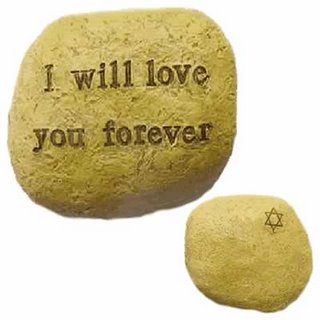See The Site


Why do we leave a Stone on the Monument ?
The practice of leaving small stones or pebbles on the monument of a loved one to commemorate a visit to the grave site is a tradition that developed hundreds of years ago and was passed down from one generation to the next.
Although most scholars can find no foundation in religion for the custom of leaving a stone by the grave site, the practice of doing so is presumed to signify the rebuilding of the monument. In early days, people did not have the ability to carve gravestones. Instead, they marked the grave site by placing many stones and rocks at the burial site. Over time, the rocks were disturbed by natural processes and the grave site required rebuilding to be identified. Thus, when technology permitted the creation of a gravestone, the practice of placing a stone at the monument became a tradition of love and respect for the departed. While widely practiced by those of the Jewish faith, many religions and cultures still practice this custom.

8 comments:
I've heared an explanation of this minhog in the name of Baba Sali's zatza"l son in law (Rabbi Machluf Aminodav Krispin shli"ta) who said, that few today know the real reason for it. The idea here is to bring a stone to the matzeyvo, and slightly hit it with the stone, or just to put it on top. This evokes the neshomo of the niftar(!). But according to this tradition, the stone shouldn't be left there, but should be removed afterwards, so the neshomo can return.
(However it is customary for many to leave the stone davka). There was a story with Reb Kalonimus ztz"l (the Rebbe of the Ariza"l's father - Reb Shloyme Luria ztz"l) who left a will, that any bypasser should leave a stone on his keyver, where subsequently a big mountain of stones was formed.
However I can't verify the accuracy of the mentioned tradition from the Baba Sali's son in law. I didn't hear it directly, neither saw it anywhere else.
supposedly the Rebbe never did put a stone on the Matzeivoh of the FR.
To correct - Rabbi Machluf Aminodav Krispin is married to a granddaughter of Baba Sali.
Do you know a reason for removing leather shoes (or shoes altogether) during hishtatchus al kivrey tzadikim? This minhog is common only amongst Russian Chasidim (Chernobyl, Karlin, Chabad etc. It seems that it was also practiced in Breslov, but today it is rarely used amongst Breslover chasidim. I found out that Reb Gedalya Kenig ztz"l used to remove shoes while going to kivrey tzadikim).
$25?! Why do things always cost more when associatied with something Jewish? Take candle sticks for example - you can buy plain silver candle sticks or you can buy silver "Shabbos" candle sticks from a Jewish store and they will cost much more.
As for stones, I brought back some stones from the ground in Sudilkov - one of which I put on the matzeivah of my great-grandfather.
I once saw written somewhere that the reason for placing a stone is for respect for the Meis, to show that the grave site is being frequented and not forsaken.
I also remember it saying that it is specifically not a Chabad custom.
I believe the reason for removing shoes is similar to the removing of one's shoes upon entering a holy place.
The Rebbe did not put stones.
Post a Comment